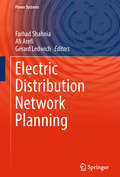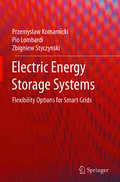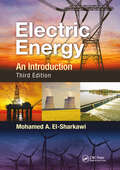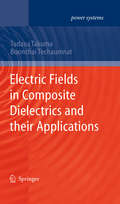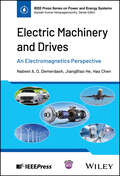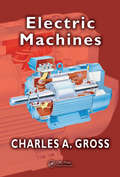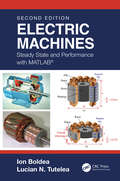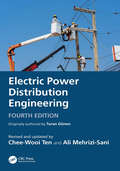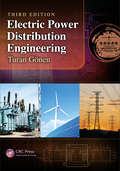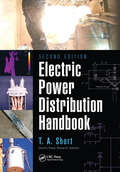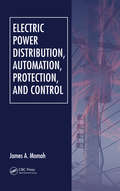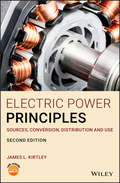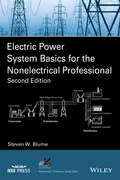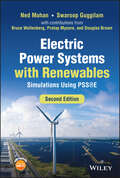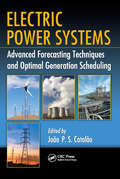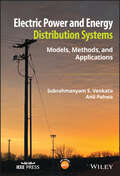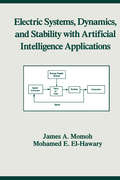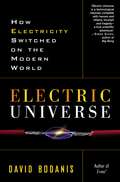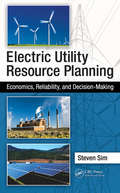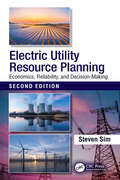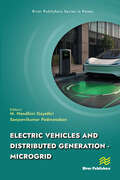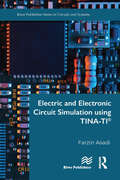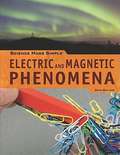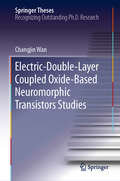- Table View
- List View
Electric Distribution Network Planning (Power Systems)
by Farhad Shahnia Ali Arefi Gerard LedwichThis book highlights the latest research advances in the planning and management of electric distribution networks. It addresses various aspects of distribution network management including planning, operation, customer engagement, and technology accommodation. Given the importance of electric distribution networks in power delivery systems, effectively planning and managing them are vital to satisfying technical, economic, and customer requirements. A new planning and management philosophy, techniques, and methods are essential to handling uncertainties associated with the integration of renewable-based distributed generation, demand forecast, and customer needs. This book covers topics on managing the capacity of distribution networks, while also addressing the future needs of electric systems. The efficient and economical operation of distribution networks is an essential aspect of ensuring the effective use of resources. Accordingly, this book addresses operation and control approaches and techniques suitable for future distribution networks.
Electric Energy Storage Systems: Flexibility Options for Smart Grids
by Zbigniew Styczynski Przemyslaw Komarnicki Pio LombardiThe book describes methods of modeling, planning and implementing electric energy storage systems. Energy storage becomes an important issue when more and more electric power is generated by wind mills and photovoltaics systems, because green energy is more volatile. So energy storage is necessary to guarantee safe and secure electric energy supply. Market and power system oriented operations of electric energy storage require different planning methods and different algorithms for searching the optimal solution. These methods are described in detail for energy storage implementations in generation, transmission and distribution levels. Economic aspects are considered. For many years, the authors have been developing smart grid solutions as well as a methology of modeling and planning electric energy storage usage. The aim has been to increase the flexibility of the power system heading for an energy system which is completely generated by green energy.
Electric Energy: An Introduction, Third Edition (Power Electronics And Applications Ser.)
by Mohamed A. El-SharkawiThe search for renewable energy and smart grids, the societal impact of blackouts, and the environmental impact of generating electricity, along with the new ABET criteria, continue to drive a renewed interest in electric energy as a core subject. Keeping pace with these changes, Electric Energy: An Introduction, Third Edition restructures the trad
Electric Fields in Composite Dielectrics and their Applications
by Tadasu Takuma Boonchai TechaumnatAn accurate quantitative picture of electric field distribution is essential in many electrical and electronic applications. In composite dielectric configurations composed of multiple dielectrics, anomalous or unexpected behavior of electric fields may appear when a solid dielectric is in contact with a conductor or another solid dielectric. The electric field near the contact point may become higher than the original field not only in the surrounding medium but also in the solid dielectric. Theoretically it may become infinitely high, depending on the contact angle. Although these characteristics are very important in a variety of applications, they have been clarified only recently using analytical and numerical calculation methods, and this is the first book to cover these new findings. Electric Fields in Composite Dielectrics and Their Applications describes the fundamental characteristics and practical applications of electric fields in composite dielectrics. The focus is on the field distribution (and the resultant force when appropriate) near points of contact. Applications include insulation design of high-voltage equipment with solid insulating supports, utilization of electrostatic force on dielectric particles in electrophotography and electrorheological fluids, and others. Electric Fields in Composite Dielectrics and Their Applications also explains the calculation methods used to analyze electric fields in composite dielectrics.
Electric Fields, Additives and Simultaneous Heat and Mass Transfer in Heat Transfer Enhancement (SpringerBriefs in Applied Sciences and Technology)
by Sujoy Kumar Saha Hrishiraj Ranjan Madhu Sruthi Emani Anand Kumar BhartiThis Brief deals with electrode design and placement, enhancement of both liquid and gas flow, vapor space condensation, in-tube condensation, falling film evaporation, correlations. It further provides a fundamental understanding of boiling and condensation, pool boiling, critical heat flux, convective vaporization, additives for single-phase liquids like solid particles, gas bubbles, suspensions in dilute polymer and surfactant solutions, solid additives and liquid additives for gases, additives for boiling, condensation and absorption, mass transfer resistance in gas phase (condensation with noncondensible gases, evaporation into air, dehumidifying finned tube heat exchangers, water film enhancement of finned tube exchanger), controlling resistance in liquid phase, and significant resistance in both phases. The volume is ideal for professionals and researchers dealing with thermal management in devices.
Electric Machinery and Drives: An Electromagnetics Perspective (IEEE Press Series on Power and Energy Systems)
by Hao Chen Nabeel A. Demerdash JiangBiao HeComprehensive resource on the fundamentals of electric machinery and variable speed drives, and their many conventional and emerging applications Electric Machinery and Drives: An Electromagnetics Perspective provides advanced concepts of electrical machinery with control/drives and emphasizes the necessity of integration of power electronics and control strategy when studying modern electrical machinery. The text incorporates the fundamentals of electric machinery, variable speed drives, and motor controls, with the scope of including both the introduction of detailed operating principles as well as the electromagnetic design and control details from scratch. The authors start with the introduction of electric circuit notations and elementary concepts of electrical circuits, power electronics, magnetostatics, magnetic circuits, and fundamentals of electromechanical energy conversion. Later, the book elaborates on the operating principles of polyphase induction machines and synchronous machines, as well as the associated scale and vector controls of these machines. To aid in reader comprehension, the text includes a solutions manual and accompanying video animations. Electric Machinery and Drives also contains information on: Real and reactive power in single-phase and balanced three-phase circuits and devices using consumer system concepts and notationsForces and torques in simple magnetically linear and nonlinear, multi-excited electromechanical devices and systemsSimplified T-equivalent circuit model and its use in performance calculations of induction machines and associated torque-slip (speed) characteristicsBrush-commutator and brushless DC machines, and natural ABC frame and Park’s two-reaction DQO frame state-space modeling of synchronous and induction machinesSpecial machines, including single-phase induction machines, switched reluctance machines, and others Electric Machinery and Drives is an ideal learning resource in undergraduate or graduate-level courses for all universities with electrical engineering programs across the world. Additionally, the text may be used as a fundamental reference by researchers and engineers in electrical, mechanical, automotive, aerospace, and automation engineering.
Electric Machines (Electric Power Engineering Series)
by Charles A. GrossThe two major broad applications of electrical energy are information processing and energy processing. Hence, it is no wonder that electric machines have occupied a large and revered space in the field of electrical engineering. Such an important topic requires a careful approach, and Charles A. Gross' Electric Machines offers the most balanced, a
Electric Machines: Steady State and Performance with MATLAB®
by Ion Boldea Lucian N. TuteleaWith its comprehensive coverage of the state of the art, this Second Edition introduces basic types of transformers and electric machines. Classifications and characterization—modeling and performance—of power electric transformers (single and multiphase), motors and generators, commercial machines (dc brush, induction dc excited synchronous, PM synchronous, reluctance synchronous) and some new ones (multiphase ac machines, switched reluctance machines) with great potential for industry with rotary or linear motion are all treated in the book. The book covers, in detail, circuit modeling characteristics and performance characteristics under steady state, testing techniques and preliminary electromagnetic-thermic dimensioning with lots of solved numerical examples and special cases to illustrate new electric machines with strong industrialization potential. All formulae used to characterize parameters and performance may be safely used in industry for preliminary designs and have been applied in the book through numerical solved examples of industrial interest. Numerous computer simulation programs in MATLAB® and Simulink® that illustrate performance characteristics present in the chapters are included and many be used as homework to facilitate a deeper understanding of fundamental issues. This book is intended for a first-semester course covering electric transformers, rotary and linear machines, steady-state modeling and performance computation, preliminary dimensioning, and testing standardized and innovative techniques. The textbook may be used by R&D engineers in industry as all machine parameters and characteristics are calculated by ready-to-use industrial design mathematical expressions.
Electric Power Distribution Engineering
by Chee-Wooi Ten Ali Mehrizi-SaniAre you fascinated by the complex web of electrical power that illuminates our modern world? Do you want to understand the intricate systems responsible for delivering electricity to our homes, businesses, and industries? Look no further than Electric Power Distribution System Engineering, Fourth Edition by renowned author Turan Gönen, revised and updated by Chee-Wooi Ten and Ali Mehrizi-Sani. This captivating book takes you on a journey through the fascinating realm of electric power distribution, offering a comprehensive yet accessible exploration of the engineering principles, technologies, and practices that underpin this vital aspect of our daily lives. Whether you're a curious non-specialist, an avid reader with a thirst for knowledge, or a librarian or bookseller seeking an invaluable resource, Gönen's masterwork will both enlighten and captivate you.An early leader in the academic market, this book provides an overview of classical planning for electric power distribution systems, which has been used for many years in designing and analyzing electric power distribution systems. The authors have taken a bold initiative to update the content, incorporating relevant aspects reflecting the advancements of today's evolving smart grid. Within its pages, readers will discover detailed discussions on the principles of power distribution, including the fundamentals of power generation, transmission, and distribution. The authors provide detailed explanations of the various components and equipment used in distribution systems, such as transformers, circuit breakers, switches, and protective devices. As part of the book, planning for the distribution network involves sizing and considering candidate geographical locations/regions in relation to the capacity of existing infrastructure, allowing for new additions to be built. For example, this includes locations either extending another feeder from distribution substations or building new distribution substations, depending on what makes more sense. Many assumptions have been made for non-existing distribution feeders to calculate ballpark figures for determining voltage profile and power losses if they were to be constructed. Readers will gain insights into how these considerations translate into net positive, net negative, or net-zero loads. All of these aspects can be gradually integrated with renewable energy sources, innovative grid technologies, and distribution automation over time.The authors involved in this book have made significant contributions to the state-of-the-art development by incorporating recent updates from the literature, thereby addressing the latest advancements. One remarkable feature of Turan Gönen's Electric Power Distribution System Engineering is its strong focus on practical applications and real-world scenarios. In addition to providing theoretical knowledge, the book also offers numerous examples that effectively bridge the gap between theory and practice. This unique approach enables readers to comprehend the intricacies of distribution system engineering and apply their newfound knowledge to solve complex problems in the field. By seamlessly blending theoretical foundations with practical insights, Gonen's book emerges as an indispensable resource for aspiring engineers, professionals, and researchers, as it offers a comprehensive understanding of electric power distribution systems and their practical implications.
Electric Power Distribution Engineering
by Turan Gönen<p>A quick scan of any bookstore, library, or online bookseller will produce a multitude of books covering power systems. However, few, if any, are totally devoted to power distribution engineering, and none of them are true textbooks. Filling this vacuum in the power system engineering literature, Electric Power Distribution System Engineering broke new ground. <p>Designed specifically for junior- or senior-level electrical engineering courses, the book covers all aspects of distribution engineering from basic system planning and concepts through distribution system protection and reliability. Drawing on decades of experience to provide a text that is as attractive to students as it is useful to professors and practicing engineers, the author demonstrates how to design, analyze, and perform modern distribution system engineering. He takes special care to cover industry terms and symbols, providing a glossary and clearly defining each term when it is introduced. The discussion of distribution planning and design considerations goes beyond the usual analytical and qualitative analysis to emphasize the economical explication and overall impact of the distribution design considerations discussed.</p>
Electric Power Distribution Handbook
by Thomas Allen ShortOf the "big three" components of electrical infrastructure, distribution typically gets the least attention. In fact, a thorough, up-to-date treatment of the subject hasn’t been published in years, yet deregulation and technical changes have increased the need for better information. Filling this void, the Electric Power Distribution Handbook delivers comprehensive, cutting-edge coverage of the electrical aspects of power distribution systems. The first few chapters of this pragmatic guidebook focus on equipment-oriented information and applications such as choosing transformer connections, sizing and placing capacitors, and setting regulators. The middle portion discusses reliability and power quality, while the end tackles lightning protection, grounding, and safety. The Second Edition of this CHOICE Award winner features: 1 new chapter on overhead line performance and 14 fully revised chapters incorporating updates from several EPRI projects New sections on voltage optimization, arc flash, and contact voltage Full-color illustrations throughout, plus fresh bibliographic references, tables, graphs, methods, and statistics Updates on conductor burndown, fault location, reliability programs, tree contacts, automation, and grounding and personnel protection Access to an author-maintained support website, distributionhandbook.com, with problems sets, resources, and online apps An unparalleled source of tips and solutions for improving performance, the Electric Power Distribution Handbook, Second Edition provides power and utility engineers with the technical information and practical tools they need to understand the applied science of distribution.
Electric Power Distribution, Automation, Protection, and Control
by James A. Momoh<p>New methods for automation and intelligent systems applications, new trends in telecommunications, and a recent focus on renewable energy are reshaping the educational landscape of today's power engineer. Providing a modern and practical vehicle to help students navigate this dynamic terrain, Electric Power Distribution, Automation, Protection, and Control infuses new directions in computation, automation, and control into classical topics in electric power distribution. <p>Ideal for a one-semester course for senior undergraduates or first-year graduate students, this text works systematically through basic distribution principles, renewable energy sources, computational tools and techniques, reliability, maintenance, distribution automation, and telecommunications. Numerous examples, problems, and case studies offer practical insight into the concepts and help build a working knowledge of protection schemes, fault analysis and synthesis, reliability analysis, intelligent automation systems, distribution management systems, and distribution system communications. The author details different renewable energy sources and teaches students how to evaluate them in terms of size, cost, and performance. <p>Guided firmly by the author's wealth of industrial and academic experience, your students will learn the tools and techniques used to design, build, and operate future generations of distribution systems with unparalleled efficiency, robustness, and sustainability.</p>
Electric Power Principles: Sources, Conversion, Distribution and Use
by James L. KirtleyA revised and updated text that explores the fundamentals of the physics of electric power handling systems The revised and updated second edition of Electric Power Principles: Sources, Conversion, Distribution and Use offers an innovative and comprehensive approach to the fundamentals of electric power. The author – a noted expert on the topic – provides a thorough grounding in electric power systems, with an informative discussion on per-unit normalisations, symmetrical components and iterative load flow calculations. The text covers the most important topics within the power system, such as protection and DC transmission, and examines both traditional power plants and those used for extracting sustainable energy from wind and sunlight. The text explores the principles of electromechanical energy conversion and magnetic circuits and synchronous machines – the most important generators of electric power. The book also contains information on power electronics, induction and direct current motors. This new second edition includes: A new chapter on energy storage, including battery modeling and how energy storage and associated power electronics can be used to modify system dynamics Information on voltage stability and bifurcation The addition of Newton’s Method for load flow calculations Material on the grounding transformer connections added to the section on three phase transformer An example of the unified power flow controller for voltage support Written for students studying electric power systems and electrical engineering, the updated second edition of Electric Power Principles: Sources, Conversion, Distribution and Use is the classroom-tested text that offers an understanding of the basics of the physics of electric power handling systems.
Electric Power System Basics for the Nonelectrical Professional (2nd Edition)
by Steven W. BlumeThe second edition of Steven W. Blume's bestseller provides a comprehensive treatment of power technology for the non-electrical engineer working in the electric power industry This book aims to give non-electrical professionals a fundamental understanding of large interconnected electrical power systems, better known as the "Power Grid", with regard to terminology, electrical concepts, design considerations, construction practices, industry standards, control room operations for both normal and emergency conditions, maintenance, consumption, telecommunications and safety. The text begins with an overview of the terminology and basic electrical concepts commonly used in the industry then it examines the generation, transmission and distribution of power. Other topics discussed include energy management, conservation of electrical energy, consumption characteristics and regulatory aspects to help readers understand modern electric power systems. This second edition features: New sections on renewable energy, regulatory changes, new measures to improve system reliability, and smart technologies used in the power grid system Updated practical examples, photographs, drawing, and illustrations to help the reader gain a better understanding of the material "Optional supplementary reading" sections within most chapters to elaborate on certain concepts by providing additional detail or background Electric Power System Basics for the Nonelectrical Professional, Second Edition, gives business professionals in the industry and entry-level engineers a strong introduction to power technology in non-technical terms. Steve W. Blume is Founder of Applied Professional Training, Inc., APT Global, LLC, APT College, LLC and APT Corporate Training Services, LLC, USA. Steve is a registered professional engineer and certified NERC Reliability Coordinator with a Master's degree in Electrical Engineering specializing in power and a Bachelor's degree specializing in Telecommunications. He has more than 25 years' experience teaching electric power system basics to non-electrical professionals. Steve's engineering and operations experience includes generation, transmission, distribution, and electrical safety. He is an active senior member in IEEE and has published two books in power systems through IEEE and Wiley.
Electric Power Systems with Renewables: Simulations Using PSSE
by Ned Mohan Swaroop GuggilamElectric Power Systems with Renewables Concise, balanced, and fundamentals-based resource providing coverage of power system operation and planning, including simulations using PSS®E software Electric Power Systems with Renewables provides a comprehensive treatment of various topics related to power systems with an emphasis on renewable energy integration into power systems. The updated use cases and methods in the book build upon the climate change science and renewables currently being integrated with the grid and the ability to manage resilience for electrifying transportation and related power systems as societies identify more ways to move towards a carbon-free future. Simulation examples and software support are provided by integrating the educational version of PSS®E. The newly revised edition includes new topics on the intelligent use of PSS®E simulation software, presents a short introduction to Python (a widely used software in the power industry), and provides new examples and back-of-the-chapter homework problems to further aid in information retention. Written by two highly qualified authors with significant experience in the field, Electric Power Systems with Renewables also contains information on: Electric energy and the environment, covering hydro power, fossil-fuel based power plants, nuclear power, renewable energy, and distributed generation (DG) Power flow in power system networks covers basic power flow equations, the Newton-Raphson procedure, sensitivity analysis, and a new remote bus voltage control concept Transformers and generators in power systems, covering basic principles of operation, a simplified model, and per-unit representation High voltage DC (HVDC) transmission systems-current-link, and voltage-link systems Associated with this textbook, there is a website from which the simulation files can be downloaded for use in PSS®E and Python. It also contains short videos to simplify the use of these software. This website will be regularly updated. Electric Power Systems with Renewables serves as a highly useful textbook for both undergraduate and graduate students in Electrical and Computer Engineering (ECE). It is also an appropriate resource for students outside of ECE who have the prerequisites, such as in mechanical, civil, and chemical engineering. Practicing engineers will greatly benefit with its industry-relevant approach to meet the present-day needs.
Electric Power Systems: Advanced Forecasting Techniques and Optimal Generation Scheduling
by João P. S. CatalãoElectric Power Systems: Advanced Forecasting Techniques and Optimal Generation Scheduling helps readers develop their skills in modeling, simulating, and optimizing electric power systems. Carefully balancing theory and practice, it presents novel, cutting-edge developments in forecasting and scheduling. The focus is on understanding and solving pivotal problems in the management of electric power generation systems. Methods for Coping with Uncertainty and Risk in Electric Power Generation Outlining real-world problems, the book begins with an overview of electric power generation systems. Since the ability to cope with uncertainty and risk is crucial for power generating companies, the second part of the book examines the latest methods and models for self-scheduling, load forecasting, short-term electricity price forecasting, and wind power forecasting. Toward Optimal Coordination between Hydro, Thermal, and Wind Power Using case studies, the third part of the book investigates how to achieve the most favorable use of available energy sources. Chapters in this section discuss price-based scheduling for generating companies, optimal scheduling of a hydro producer, hydro-thermal coordination, unit commitment with wind generators, and optimal optimization of multigeneration systems. Written in a pedagogical style that will appeal to graduate students, the book also expands on research results that are useful for engineers and researchers. It presents the latest techniques in increasingly important areas of power system operations and planning.
Electric Power and Energy Distribution Systems: Models, Methods, and Applications (IEEE Press)
by Anil Pahwa Subrahmanyam S. VenkataElectric Power and Energy Distribution Systems Provides a comprehensive introduction to today’s electric power distribution systems, perfect for advanced students and industry professionals Due to growth of renewable resources and advances in information technology, electric power distribution systems have undergone significant changes over the past fifteen years. The expansion of technologies such as consumer rooftop solar panels, electric vehicles, smart energy storage, and automated metering infrastructure make planning and operating power distribution systems challenging. Integration of advanced technologies at the distribution level is critical for realizing higher efficiency, reliability, resiliency, and flexibility. Electric Power and Energy Distribution Systems: Models, Methods, and Applications provides comprehensive coverage of the key aspects of conventional and emerging distribution systems, including modeling, methodologies, analysis, planning, economics, distribution automation, reliability, grounding, protection, power quality, and distributed energy resources. Written by experts with decades of experience in academia and industry, this textbook integrates theory and practice to present a well-balanced treatment of topics relevant to modern electric power distribution systems. Detailed chapters address modeling of distribution system components, load characteristics and optimal selection of devices, microgrids and other types of energy resources, the challenges associated with the planning and operation of distribution systems, and more. Covers a wide range of both legacy and contemporary issues supported by rigorous analysis and practical insights Provides in-depth examination of outage management, voltage control, system restoration, and other operational functions Features real-world case studies of distribution automation functions in urban and rural power systems Discusses technologies for distributed energy resources (DER) with a focus on wind, solar, and battery storage Describes fundamental economics in the context of power distribution systems, such as the impact of tariffs on selling electricity to consumers of different types Explains the architecture of distribution system protection, including fuses, reclosers, overcurrent relays, and grounding practices The ideal textbook for advanced undergraduate and first-year graduate courses, Electric Power and Energy Distribution Systems: Models, Methods, and Applications is also an excellent reference for professionals with limited prior knowledge about distribution systems.
Electric Systems, Dynamics, and Stability with Artificial Intelligence Applications (Power Engineering #8)
by Mohamed E. El-Hawary James A. MomohThis work seeks to provide a solid foundation to the principles and practices of dynamics and stability assessment of large-scale power systems, focusing on the use of interconnected systems - and aiming to meet the requirements of today's competitive and deregulated environments. It contains easy-to-follow examples of fundamental concepts and algorithmic procedures.
Electric Universe
by David BodanisIn his bestselling E=mc2, David Bodanis led us, with astonishing ease, through the world's most famous equation. Now, in Electric Universe, he illuminates the wondrous yet invisible force that permeates our universe--and introduces us to the virtuoso scientists who plumbed its secrets.For centuries, electricity was seen as little more than a curious property of certain substances that sparked when rubbed. Then, in the 1790s, Alessandro Volta began the scientific investigation that ignited an explosion of knowledge and invention. The force that once seemed inconsequential was revealed to be responsible for everything from the structure of the atom to the functioning of our brains. In harnessing its power, we have created a world of wonders--complete with roller coasters and radar, computer networks and psychopharmaceuticals.A superb storyteller, Bodanis weaves tales of romance, divine inspiration, and fraud through lucid accounts of scientific breakthroughs. The great discoverers come to life in all their brilliance and idiosyncrasy, including the visionary Michael Faraday, who struggled against the prejudices of the British class system, and Samuel Morse, a painter who, before inventing the telegraph, ran for mayor of New York City on a platform of persecuting Catholics. Here too is Alan Turing, whose dream of a marvelous thinking machine--what we know as the computer--was met with indifference, and who ended his life in despair after British authorities forced him to undergo experimental treatments to "cure" his homosexuality.From the frigid waters of the Atlantic to the streets of Hamburg during a World War II firestorm to the interior of the human body, Electric Universe is a mesmerizing journey of discovery by a master science writer.From the Hardcover edition.
Electric Utility Resource Planning: Economics, Reliability, and Decision-Making
by Steven SimMost people—including many legislators, regulators, and other decision makers in the electric utility industry—have misconceptions about how electric utilities really "work" and plan for the future. This lack of understanding can lead to poorly informed decisions and policies that directly affect the choices utilities must make. Using easy-to-understand text and examples, Electric Utility Resource Planning: Economics, Reliability, and Decision-Making clarifies how utilities operate their systems and prepare for the future. This explanation will show readers that both expected and counterintuitive results can occur (i.e., conservation might result in higher air emissions, or lowering costs could lead to higher electric rates). Taking readers step by step through this process, the book (in the following order): "Creates" a hypothetical utility Explains how and why a utility operates its system of generating units Discusses the planning methods that a utility would (or should) use Guides readers through each stage of a planning analysis for the hypothetical utility, examining various resource options (conservation, new power plants, and solar) In addition, the author introduces four Fundamental Principles of Resource Planning that should guide utilities. He also offers opinions on how certain trends in utility regulation and legislation can hinder utility planners’ efforts to identify and select the best resources for the utility’s customers. With this book, author Dr. Steven Sim applies his experience and insights from more than two decades of resource planning for Florida Power and Light (FPL). As one of the largest utilities in the United States, FPL has faced a multitude of resource planning challenges, and Dr. Sim has performed and supervised thousands of analyses designed to meet these obstacles. He has also served as an FPL witness in regulatory hearings on a wide variety of topics, ranging from the economic implications of nuclear, conservation, coal, gas, and other resource options, to the non-economic impacts (air emissions, fuel usage, system reliability, etc.) they present.
Electric Utility Resource Planning: Economics, Reliability, and Decision-Making
by Steven SimIn 2012, using easy-to-understand text and examples, the first edition of this book explained how electric utilities “work,” and how they plan (or should plan) for the future, by: "Creating" a hypothetical electric utility Explaining how (and why) this utility will operate its system of generating units Guiding readers through a planning analysis for the utility, examining various resource options (solar, new gas-fueled generation, and conservation) Introducing four Fundamental Principles of Resource Planning that should guide utilities as they plan for the future The first edition material, with significant updates, now appears as Part I of the second edition of this book. Part II of this book then presents six all-new chapters that address the challenges (and opportunities) of moving toward a zero-carbon future. Using the same hypothetical utility, with its new goal to utilize solar and batteries to serve 100% of its customers’ energy with zero carbon emissions by a future “target”year, Part II of this book addresses many subjects, including: The enormous amount of MW of new solar and batteries the utility will need to add Why certain characteristics of new solar and battery additions change as increasing amounts of these resources are added In the years prior to achieving its zero-carbon goal, how the hourly operation of the utility’s existing fossil-fueled generators, plus the new solar, will change (and why the stability of the transmission grid will be challenged) With this second edition, author Dr. Steven Sim again applies the experience and insights he gained from more than 30 years of resource planning for Florida Power & Light (FPL). As one of the largest electric utilities in the United States, FPL has faced a multitude of resource planning challenges, including how to get to zero carbon. During this time period, Dr. Sim performed and directed thousands of analyses designed to address these challenges. He also served as an expert witness in dozens of regulatory hearings, addressing both the economics of resource options and the non-economic impacts (air emissions, system reliability, fuel usage, etc.) associated with these options.
Electric Vehicles and Distributed Generation - Microgrid (River Publishers Series in Energy Management)
by Sanjeevikumar Padmanaban M. Nandhini GayathriThis book reviews advanced innovations and future perspectives for electric vehicle (EV) charging and distributed generation via micro grids. It includes clear points, diagrams, and technical details to aid researchers, scholars, and students in optimizing EV-grid integration.In this book, the information, data, insights, facts, and knowledge provided will encourage and assist the scholars, researchers, authors, and students in learning the necessary technical specifications of electric vehicles integrated with the grid. This knowledge will also help readers understand the communication protocols used and analyze the optimization of vehicular power when the vehicle is integrated with the grid.It will also help new research scholars by providing them with a complete knowledge regarding power converter topology, and power quality assessment in EV clusters. This book provides an excellent approach for both wired and wireless charging of electric vehicles and grid integration. It includes the most advanced contents in wireless charging of electric vehicles, power converters using wide bandgap devices and the integration of electric vehicles with the grid.
Electric and Electronic Circuit Simulation using TINA-TI®
by Farzin AsadiA circuit simulator is a computer program that permits us to see circuit behavior, i.e. circuit voltages and currents, without making the circuit. Use of a circuit simulator is a cheap, efficient, and safe way to study the behavior of circuits. The Toolkit for Interactive Network Analysis (TINA®) is a powerful yet affordable SPICE based circuit simulation and PCB design software package for analyzing, designing, and real time testing of analog, digital, VHDL, MCU, and mixed electronic circuits and their PCB layouts. This software was created by DesignSoft. TINA-TI is a spinoff software program that was designed by Texas Instruments (TI®) in cooperation with DesignSoft which incorporates a library of pre-made TI components for the user to utilize in their designs. This book shows how a circuit can be analyzed in the TINA-TI® environment. Students of engineering (for instance, electrical, biomedical, mechatronics, and robotics to name a few), engineers who work in the industry, and anyone who wants to learn the art of circuit simulation with TINA-TI can benefit from this book.
Electric and Magnetic Phenomena (Science Made Simple)
by Dean GalianoThis book introduces the discovery that electric and magnetic phenomena are a result of positive and negative charges interacting with each other; researchers were able to isolate the negatively charged electron.
Electric-Double-Layer Coupled Oxide-Based Neuromorphic Transistors Studies (Springer Theses)
by Changjin WanThis book focuses on essential synaptic plasticity emulations and neuromorphic computing applications realized with the aid of three-terminal synaptic devices based on ion-coupled oxide-based electric-double-layer (EDL) transistors. To replicate the robust, plastic and fault-tolerant computational power of the human brain, the emulation of essential synaptic plasticity and computation of neurons/synapse by electronic devices are generally considered to be key steps. The book shows that the formation of an EDL at the dielectric/channel interface that slightly lags behind the stimuli can be attributed to the electrostatic coupling between ions and electrons; this mechanism underlies the emulation of short-term synaptic behaviors. Furthermore, it demonstrates that electrochemical doping/dedoping processes in the semiconducting channel by penetrated ions from electrolyte can be utilized for the emulation of long-term synaptic behaviors. Lastly, it applies these synaptic transistors in an artificial visual system to demonstrate the potential for constructing neuromorphic systems. Accordingly, the book offers a unique resource on understanding the brain-machine interface, brain-like chips, artificial cognitive systems, etc.
